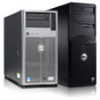Dell PowerEdge XL 5133-4 Dell PowerEdge M I/O Aggregator Getting Started Guide - Page 7
Introduction, Product Description
 |
View all Dell PowerEdge XL 5133-4 manuals
Add to My Manuals
Save this manual to your list of manuals |
Page 7 highlights
Introduction This document provides basic information about the Dell PowerEdge M I/O Aggregator, including how to install the switch in the Dell PowerEdge M1000e Enclosure and perform the initial configuration. For more detailed information about any of the basic installation steps, refer to the Dell PowerEdge M1000e Enclosure Owner's Manual on the Dell Support website at http://support.dell.com/manuals. Product Description The I/O Aggregator is a zero-touch, layer 2 switch blade with two fixed 40GbE ports on the base module and support for two optional plug-in modules. The Aggregator operates in a Dell PowerEdge M1000e chassis, which can support up to 32 servers and six I/O Aggregator blade switches. The Aggregator runs the Dell Force10 Operating System (FTOS) and autoconfigures as an unmanaged switch with bridging and multiplexing functionality, which transmits traffic as follows: • GbE/10GbE connections through the midplane to up to 32 server ports in the chassis • 10GbE connections through uplink ports to top-of-rack (ToR) switches • 40GbE connections through stacking ports to other I/O Aggregators in a switch stack In a data center network, the Aggregator functions as a flat layer 2 passthrough switch that interoperates with Dell and third-party ToR devices. The switch supports data center bridging (DCB) features, and provides seamless connectivity for a Fiber Channel over Ethernet (FCoE) server and iSCSI storage data traffic. In its default operational mode, the Aggregator requires no additional configuration; network connectivity for servers in an M1000e chassis is enabled. By simplifying switch configuration and management, the Aggregator reduces complexity in a data center network. Introduction 7















